
EB-2023-0684 | December 2023
Important Apple Cultivars in the Mid-Atlantic Region
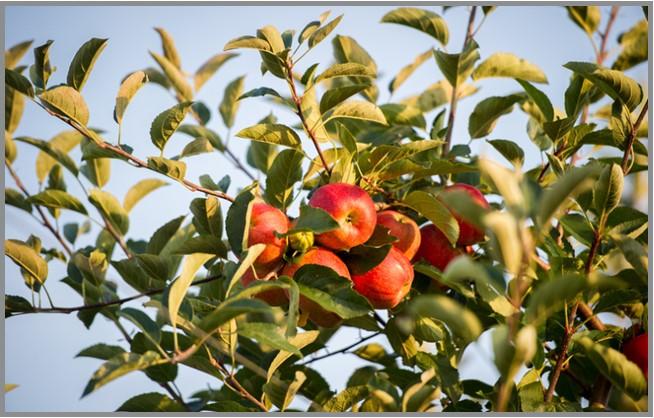
Choosing the right apple cultivar is a crucial decision when establishing a commercial apple orchard, as it can directly impact the economics and profitability of your venture. With the growing breeds of apple cultivars now available in the market, making this choice can be a difficult task. Key factors such as tree growth characteristics, fruit quality properties, harvest dates, as well as the target market for your cultivar can help you narrow down the choices. Being well-informed and carefully selecting cultivars that align with your specific requirements and thrive in your environmental conditions is essential for your orchard's success.
Apple Cultivars and Important Selection Considerations
Apple cultivars represent the diverse range of apples available to consumers, each with its own unique combination of traits. Consider traits such as tree growth characteristics, apple fruit quality, harvest dates, as well as target market for the cultivar when selecting which cultivar to plant. Tree growth characteristics include aspects such as: soil and nutritional requirements; pollination requirements; tree size; rootstock compatibility; pruning and training requirements; disease resistance; precocity; as well as adaptability to different growing regions. Apple fruit quality properties comprise fruit skin and flesh color; texture; flavor; appearance; nutritional value; storability capacity; as well as overall consumer preferences and cultivar popularity. Harvest timing is also important to consider, as these will vary amongst different cultivars, allowing for a diverse supply of apples throughout the year. For example, early ripening cultivars generally need specific temperature and light characteristics for optimal skin color development, which are not achievable under different environmental conditions, particularly in the hot and humid weather of the mid-Atlantic. On the other hand, late ripening cultivars need to reach full maturity and required skin coloration before freezing temperatures occur. Lastly, you should consider the target market, as pick-your-own, farmer’s markets, roadside markets, and wholesale fresh market will all need a continuous supply of apples to ensure your operation remains profitable.
Important Apple Cultivars for the Mid-Atlantic Region of the United States
Listed below are brief descriptions of various commercially important cultivars for the mid-Atlantic Region of the United States. Cultivars are listed by early/ mid/ late ripening season (and within each season, in alphabetical order). Note that some cultivars have strains, a genetically distinct population within a cultivar that can arise due to natural variations, mutations, or intentional breeding efforts aimed at developing specific traits. Strains may exhibit slight variations in characteristics compared to the parent cultivar. Much of this information has been compiled from results generated from breeders, tree nurseries as well as growers and packers. A summary table is also included with some important characteristics for each cultivar (Table 1).
| Cultivar Name | Ripening Season | Skin Color | Size | Shape | Taste |
|---|---|---|---|---|---|
| Gala | Early-Mid | Cream to red, yellow stripe | Small to medium | Round (orange) | Sweet |
| Ginger Gold | Early | Pale green with minimal red blush | Medium to large | Round or conical | Sweet tangy |
| Zestar!® | Early | Red | Medium to large | Globose | Sweet tart |
| Autumn Crisp | Mid | Bright red blush | Small to medium | Round or slightly conical | Sweet tart |
| Braeburn | Mid | Red over yellow/green background | Small to medium | Oval | Sweet tart |
| Cortland | Mid | Deep purple red color with yellow streaks | Medium to large | Roundish oblate | Sweet tart |
| Crimson Crispᵀᴹ | Mid | Deep red purple | Small to medium | Round | Sweet tart |
| Golden Delicious | Mid | Pale green to golden yellow | Medium | Conical to oblong | Sweet |
| Granny Smith | Mid | Bright green with grey dots | Medium to large | Round | Tart |
| Honeycrispᵀᴹ | Mid | Bi-color (variable red with green/cream color) | Medium to large | Round to slightly oblong | Sweet tangy |
| Macoun | Mid | Deep red over green base | Medium to large | Boxy | Sweet tart |
| McIntosh | Mid | Two toned (red and green) | Small to medium | Round | Sweet tart |
| Ambrosia | Mid-Late | Bi color (smooth red with yellow) | Medium | Round top with tempered bottom | Sweet |
| Empire | Mid-Late | Deep red brushed with gold and green | Medium to large | Round | Sweet tart |
| Jonagold | Mid-Late | Orangish red | Large | Slightly conical | Sweet tart |
| Red Delicious | Mid-Late | Bright red | Medium | Long conical | Sweet |
| Cameo® | Late | Dark red flush to pale green | Medium to large | Round | Sweet tart |
| Cripps Pink | Late | Pink/red mix over green | Medium | Oblong | Sweet tart |
| Evercrisp | Late | Red | Large | Round | Sweet tart |
| Fuji | Late | Medium to large | Round to conical | Sweet tart | |
| Gold Rush | Late | Golden with bronze to red blush | Medium to large | Round to slightly oblong | Sweet tart |
| Idared | Late | Bright crimson | Large | Round | Sweet tart |
| Rome Beauty | Late | Deep red | Medium to large | Round | Sweet tart |
| York | Late | Deep red with greenish-yellow streaks | Medium to large | Round | Sweet tart |
Early & Early to Mid-season Cultivars
Gala

Gala is a result from a cross between Golden Delicious and Kidd’s Orange Red apples. Galas were discovered in New Zealand in 1934. Gala generally produces small fruit, particularly if trees are not well managed. It is one of the most widely grown apples in the world and can vary in color, from cream to red and yellow striped. It is crunchy and juicy, with a sweet, pear-like flavor. It is well suited for fresh consumption, for cooking, and for baking. Gala is classified as an early- to mid-season cultivar. Apple growers around the world have successfully developed and grown many different strains of Gala with the goal of improving the fruit’s size and red color. Galas are susceptible to stem cracks, fruit cracks and flesh browning.
Ginger Gold
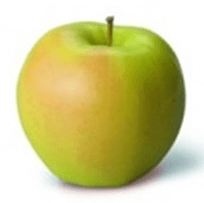
Ginger Gold is a chance seedling that was discovered growing near a Golden Delicious orchard in Virginia in the 1960s. The parents are likely to be Golden Delicious, Albemarle Pippin, and another unknown variety. The color, shape, and distinctive long stem of Ginger Gold are characteristics of its Golden Delicious parent. The fruit starts out a very pale green, although if left on the tree it will ripen to a soft yellow with a slightly waxy appearance with minimal blush. It is characterized by a balanced, firm-dry texture. Fruit finish is very good with little russeting. Ginger Gold is an early ripening cultivar. It has a very short harvest window and can quickly over-mature. Storage potential is rated as very good (approximately 2 months) for an early cultivar.
Zestar!®
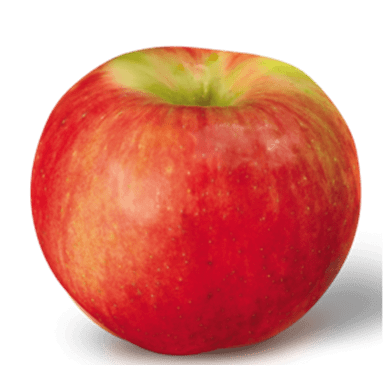
Zestar!® apple results from the cross between State Fair and MN 1691. The latter is a selection from the breeding program at the University of Minnesota. Zestar!® comes from the University of Minnesota breeding program. The apples are globose, with an average diameter of approximately 3 inches and are characterized by red striping. Where the sun shines on the fruit, a bright rosy-red blush develops. Shaded areas are often creamy yellow. Its flavor profile is characterized by a sprightly sweet-tart taste with a hint of brown sugar, and it is juicy with a light, crisp texture. It is an early-season cultivar. It has become a favorite of direct-market and small wholesale apple growers in the East and Midwest. Zestar!® is generally known for its shelf life, not for its storage (although it can last approximately 2 months in storage). This variety is also prone to drop.
Mid-Season Cultivars
Autumn Crisp
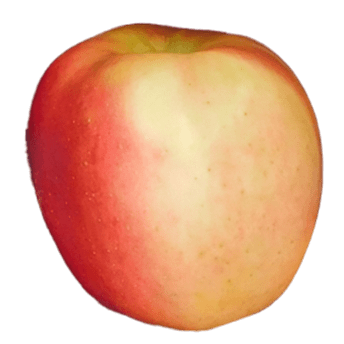
Autumn Crisp was developed at Cornell University from a cross of Golden Delicious and Monroe. The bright red blush fruit has a white flesh that is slow to oxidize. Although the name is similar, this cultivar is not related to Honeycrisp. The texture is similar, and the fruit are very juicy. Autumn Crisp’s harvest time occurs mid-season. While developed for fresh consumption, it was also discovered to be great for use as a processing type and thus has attributes for both fresh eating and baking.
Braeburn
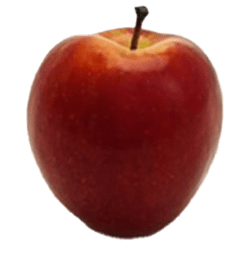
Braeburn is a chance seedling from New Zealand, with a parentage of Lady Hamilton x an unknown (possibly Granny Smith). Fruit are oval, small to medium with slightly red shoulders over a yellow/green background and may have greenish-yellow sections with red blush. It has a sweet-tart flavor profile and is characterized by being juicy and crisp textured. It is a mid-season cultivar with a long storage duration (approximately 10 months). The cultivar is very precocious, and growers should avoid fruiting the trees too soon.
Cortland

Cortland is a breed from a cross between McIntosh and Ben Davis. It was first grown at the New York State Agricultural Experiment Station in Geneva, New York, in 1898. The fruit are roundish oblate, medium to large, attractively colored red, with a crisp and juicy white flesh. Cortland is a mid-season apple cultivar. It is a high ethylene producer like one of its parents, McIntosh. Overmature Cortland is known to become greasy, mushy, and have a shorter storage life. Fruit are all-purpose apples that are they are excellent for cooking/baking and for use in salads, as the flesh is non-browning. The trees generally set heavy crops. Strains with better coloring capacity include Redcort and Royal Court.
Crimson Crisp™
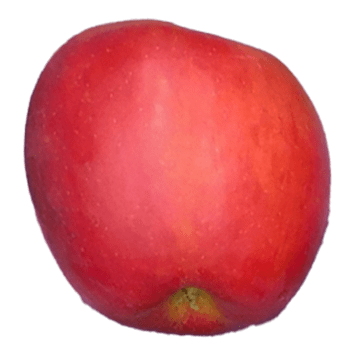
Crimson Crisp™ is a hybrid of two advanced selections from the PRI Apple Breeding Program of Purdue University, Rutgers University, and the University of Illinois. The fruit are attractive and small to medium in size. They are firm, deep red-purple colored, and crunchy apple, with a crispy yellow flesh that holds a sweet-tart flavor. Crimson Crisp™ is a mid-season cultivar. Fruit can be stored for at least four months.
Golden Delicious
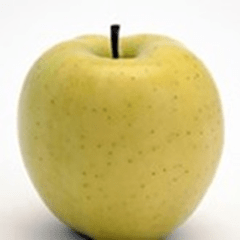
Golden Delicious is a chance seedling found in West Virginia in the early 1900s. It is possibly a hybrid of Grimes Golden and Golden Reinette. It is a medium size apple. Fruit is pale green to golden yellow in color, and it is characterized by an aromatic, balanced, slightly juicy, and crisp texture. Golden Delicious is a mid-season apple. It is very prone to bruising and shriveling. As a result, the cultivar requires careful handling and storage. Golden Delicious trees tend toward biennial bearing.
Granny Smith
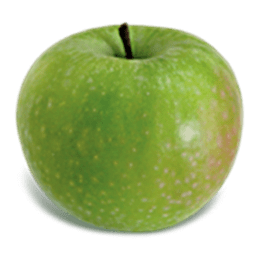
Granny Smith is a chance seedling found in Australia in the 1860s. The parentage is unknown, but it is believed that it possibly grew from the seed of French Crab. It is a medium- to large-sized apple. Fruit is medium-dark green, often with a slight blush. The flesh is greenish white and very crisp. From a taste perspective, it is a tart apple, good for culinary purposes and fresh eating. Granny Smith is a mid-season apple. It is a long-keeping apple, possibly due to its low ethylene production.
Honeycrisp™
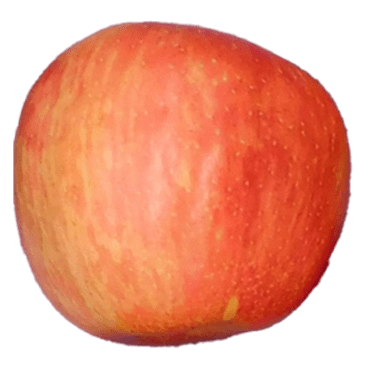
Honeycrisp™ is a modern apple variety resulting from a cross between Keepsake and MN1627. It was developed in the 1960s and introduced in 1990 by the University of Minnesota. Honeycrisp is a bicolor cultivar with medium to large fruit. The cultivar is known for its exceptional taste balancing sweet and tart as well as for its crisp texture. Honeycrisp is a mid-season apple cultivar. In the mid-Atlantic, Honeycrisp has problems in reaching the 50-60% red skin blush required by the industry for this specific cultivar, due to the hot and humid environmental conditions. Newer strains of Honeycrisp result in redder fruit. The most familiar strains are:
- Premier Honeycrisp™ (ripens three weeks before the standard Honeycrisp),
- Royal Red Honeycrisp® (colors earlier and has higher sugar content than the standard Honeycrisp),
- Firestorm Honeycrisp™ (colors better than standard Honeycrisp, even under environmental conditions with high heat).
Honeycrisp is prone to several storage disorders (e.g. bitter pit, soft scald, soggy breakdown, and senescent breakdown) and storage rots, which make long-term storage challenging. It is a high ethylene producing variety, but Honeycrisp can have significant preharvest drop in hot years.
Macoun
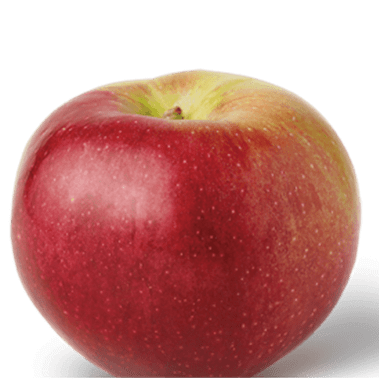
Macoun apples are a cross between the McIntosh and Jersey Black, developed by Cornell University, New York, in 1923. Macoun is a medium- to large-sized apple, with deep red color over a green base. It is considered one of the best-tasting apples, especially fresh from the tree, due to its crispy, juicy white flesh and rich, complex flavors of strawberry and spices. It is a mid-season cultivar. Similar to its parent McIntosh, Macoun is a high-ethylene-producing cultivar and can experience high levels of preharvest fruit drop. Furthermore, Macoun has a short stem, which can exacerbate fruit drop if trees are overcropped, as the apple has a tendency to push itself off the branch as the fruit matures.
McIntosh
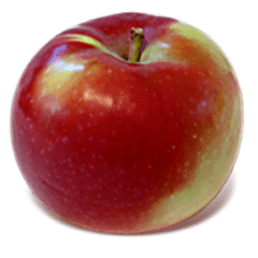
McIntosh and the related Mac Types (Mac) originated as a chance seedling variety discovered in Ontario, Canada, in the early 18th century. It is considered a cross of Detroit Red and Fameuse (Snow). McIntosh apples are small- to medium-sized, round fruit with a short stem, with two-toned red and green skin. The fruit is crisp but not hard, slightly tart white flesh with berry-like aroma and high juiciness. It is a mid-season cultivar that grows best in cool areas with cold nights; otherwise, it suffers from poor color, soft flesh, and excessive pre-harvest fruit drop. Macs are also prone to scald, flesh softening, and chilling sensitivity in storage. Currently, there are several Mac-type apples (such as RubyMac®, Acey Mac, and Rogers Mac) that vary in color, harvest time, and susceptibility to fruit drop. McIntosh is unique because produces high amounts of internal ethylene and has considerable variation in ripening. Some apples may mature early and produce significant ethylene, while many others on the same tree remain green.
Mid- to Late Season Cultivars
Ambrosia

Ambrosia was originally discovered as a chance seedling in British Columbia, Canada, in the early 1990s. Although the parents are unknown, it is likely a cross between Jonagold and Golden Delicious. Ambrosia is a bicolored medium-sized apple, fine grained and sweet with a smooth red over yellow finish with no russeting. It can be challenging to color, especially in warm sites such as the mid-Atlantic. Coloring often occurs late in the season and is heavily dependent on diurnal temperature variations. Ambrosia’s harvest time occurs mid- to late-season and it ripens at the same time, or just before, Jonagold. Trees are upright growing and difficult to spread. The growth habit is that of a semi-spur and branches break out easily when trying to spread them.
Empire
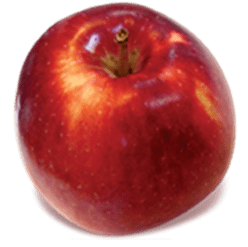
Empire is a cross between McIntosh and Red Delicious, developed at Cornell University, New York, in 1945, and introduced in the 1960s. Empire apples are sweeter than a McIntosh and tarter than a Delicious, with juicy, firm, white flesh. It has a striking, deep red skin brushed with gold and green. These fruit do not bruise easily and are excellent for eating and salads. They are also good for applesauce, for baking, for fresh cut consumption, and for freezing. Empire is a mid-late season apple. It is bred to resist preharvest fruit drop, but if it is left on the tree too long to enhance its color, its storage quality drops quickly.
Jonagold
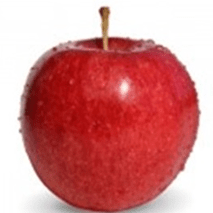
Jonagold is a cross between Golden Delicious and Jonathan, and was developed at Cornell University, New York in 1953. It is a large, slightly conical apple with an orangish-red blush. Its flesh is explosively crisp and juicy, like Honeycrisp, but with more apple flavor. Jonagold is a mid-late season cultivar. The fruit of most Jonagold strains do not develop sufficient red blush (as required by the industry), even when firmness, starch index, and other maturity indices suggest the fruit is ready for harvest. To improve fruit color, growers tend to delay harvest, but Jonagold may then become greasy and vulnerable to watercore as well as to rapid breakdown during subsequent cold storage.
Red Delicious
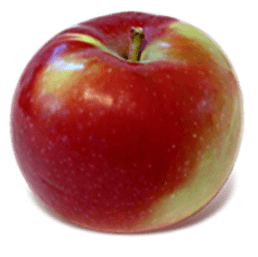
Red Delicious and the related red types correspond to chance seedlings discovered in 1870 on a farm in Iowa from unknown parentage. It is a medium-sized apple, with a distinctive tall conical shape. Red Delicious fruit have a bright red color and are known for the high consistency of their texture. It is a sweet apple, lightly aromatic with a firm, cream-colored flesh. Red Delicious also has a great storability capacity. It is a mid-late season cultivar. It is prone to pre-harvest fruit drops and, in some years, bitter pit. It can also be susceptible to watercore development both during ripening on the tree and during storage. Breeders have developed numerous strains of Red Delicious, including Oregon Spur, Otago, Red Chief, Red King, Red Spur, Richared, Starking, Starkrimson®, and Starkspur®.
Late Season Cultivars
Cameo® (Caudle)
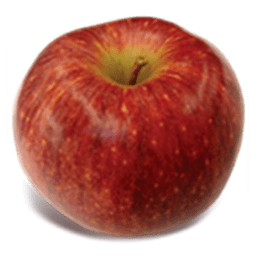
Cameo® (Caudle) is the registered trademark brand name of the Caudle variety, discovered by chance in Washington State in 1987, near orchards of Red Delicious and Golden Delicious. Cameo® is a medium to large apple. Its color varies considerably, from a dark red flush to a pale green and can have even some orange flushes. It has a sweet-tart taste and tolerance to flesh browning, which makes it ideal for use in baking/cooking. It is a late season cultivar. It has a long harvest window, as well as an extended storability.
Cripps Pink (Pink Lady®)
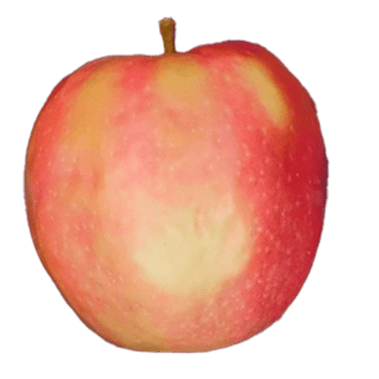
Cripps Pink (Pink Lady®) is a cross between Golden Delicious and Lady Williams. It was developed in the 1970s in Western Australia. The fruit are medium in size and oblong in shape. It has a distinctive pink/red color mixed with a green background with cream-colored flesh. It is a firm, crisp, tart and honey-sweet apple with a long postharvest storage. Cripps Pink is a very late-season cultivar, normally harvested after other late-season cultivars such as Fuji, that requires a 200-day growth period. For this reason, it cannot be grown in higher latitudes or regions subjected to early winter freezes. Early Cripps Pink strains such as Barnsby or Maslin ripen about 3 weeks earlier than the regular Cripps Pink, and, in some years, may develop fruit drop issues. Cripps Pink is a relatively moderate to high ethylene producer. Trees are vigorous and upright growing.
EverCrisp or “MAIA-1”
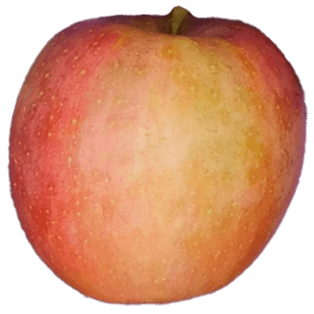
EverCrisp or “MAIA-1” is the first cultivar developed by the Midwestern Apple Improvement Association (MAIA), a private grower funded organization. It is a hybrid of Fuji and Honeycrisp, combining the sweet flavor of Fuji with some of the crispy texture attributes of Honeycrisp. Evercrisp is a late-season apple. The tree is productive, and the fruit are described as sweet with a long harvest and storage window. EverCrisp is very susceptible to watercore (water-soaked tissues in the apples’ core). Growers wishing to purchase EverCrisp trees must be a member of MAIA and agree to pay a royalty per tree once the trees begin producing.
Fuji
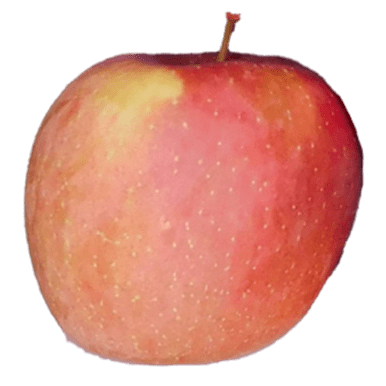
Fuji was developed in Japan in the late 1930s and released in 1962. It is a cross between Red Delicious and Ralls Janet. Fruit are medium-sized, round to conical. The color variation of Fuji is quite wide, ranging from light pink to crimson pink. The fruit is crisp, firm, and juicy, with dull white flesh which snaps cleanly. The flavor is predominantly sweet, making them popular with consumers worldwide. In general, Fuji is a late-ripening variety with a very long shelf life. Many strains have since been recognized and propagated. Some Fuji strains, however, have a slightly earlier harvest. Some of the most common Fuji strains are Aztec Fuji®, September Wonder®, Stark® Super Red, Kiku® Fuji, and Fuji Suprema. Fuji is very susceptible to watercore (water-soaked tissues in the apples’ core) and, in some years, to fruit cracking. If harvested too early, it may develop soft scald (brown soft sunken discoloration patches in the skin tissue) due to prolonged cold storage. Because the trees bear fruit every two years, growers must ensure that the trees are adequately thinned.
Gold Rush
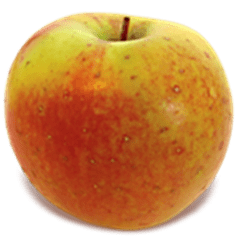
Gold Rush is derived from a cross made in 1972 between Golden Delicious and Co-op 17 (PRI 1689- 110) at Purdue University. The fruit skin is golden, often mixed with some greenish yellow, with an occasional bronze to red blush tint at harvest. It can become entirely deep yellow in storage. The color is much more pronounced than in Golden Delicious. It is characterized by being a crunchy, aromatic, but at the same time sweet and tart apple cultivar. Gold Rush is a late-maturing apple with excellent fruit quality and long storage ability. The low internal ethylene concentration of Gold Rush may be responsible for its longer storage life, but the moisture content needs to be regulated to prevent apple shriveling in storage.
Idared

Idared is a cross between Jonathan and Wagener that was developed at the University of Idaho in 1942. Idared is a large apple with a bright crimson peel. It is a crisp apple when first picked, with good flavor that is tangy and tart as well as aromatic, and that becomes sweeter and more complex over time. The fruit is very firm, making it excellent for the processing market. Idared is a late-season apple cultivar and has a remarkably long storage potential. Nevertheless, in years with very good fruit coloring conditions, Idared apples are prone to producing excessive anthocyanins in the flesh (called flesh bleeding) which, when processed, results in an undesirable, pink-colored applesauce.
Rome Beauty
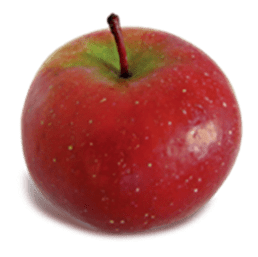
Rome Beauty (also known as Red Rome, Rome Beauty, or Gillett’s Seedling) originated by a chance seedling in Ohio, in the early 19th century. The cultivar produces a medium to large round-shaped apple, with deep-red skin coloration. Rome’s flesh is crisp, firm and greenish-white, with a slightly tart taste. In general, this cultivar has good storage capabilities. It is a late-season cultivar and Rome Beauty is one of the few US heirloom varieties that can be found in many of the warmer apple growing regions. It is a good apple eaten fresh, but it is particularly good for processing or baking. Like Idared, Rome Beauty apples are prone to producing excessive flesh bleeding, resulting in an undesirable pink-colored applesauce when processed. Processing Rome apple growers are seeking characteristics such as maintained fruit firmness, reduced greasiness, and low levels of internal flesh bleeding.
York or York Imperial
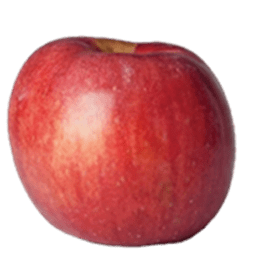
York or York Imperial was discovered in Pennsylvania in 1820. It produces fruit of medium to large size with deep red skin that include greenish-yellow streaks and specks, as well as occasional patches of yellow or green. It is juicy and slightly aromatic, with a semi-sweet flavor that is excellent for baking and cider-making. It is a late-season apple cultivar.
Conclusions
New apple cultivars have been and will continue emerging, the results of both by chance in nature and by apple breeding programs around the world. Apple cultivars play a crucial role in the improvement of profitability and economics of commercial apple orchards. Growers should stay informed about the latest cultivar research and routinely replant orchard blocks to new apple cultivars that comply with market requirements, such as improved fruit quality; resistance to multiple diseases; good postharvest storage characteristics; desirable growth habit; annual fruiting habit; and delayed bloom. It is of paramount importance to conduct a trial planting with a small number of trees before embarking on large-scale plantings of a new cultivar. This preliminary step ensures that the cultivars not only meet production and target market requirements but also thrive in the specific environmental conditions where they will be established.
For More Information
- New England Apple Association. Link: https://newenglandapples.org/apples/
- New York Apples Association. Link: https://www.applesfromny.com/varieties/
- Virginia Apple Board. Link: https://www.virginiaapples.net/apple-varieties
- Washington State University, Tree Fruit. Link: https://treefruit.wsu.edu/varieties/
MD SHIPON MIAH
M.S. Student in Plant Science
shipon@umd.edu
MACARENA FARCUH, PH.D.
Assistant Professor and Extension Specialist, University of Maryland, College Park
mfarcuh@umd.edu
All photos by Dr. Macarena Farcuh, University of Maryland unless otherwise noted
This publication, Important Apple Cultivars in the Mid-Atlantic Region (EB-2023-0684), is a part of a collection produced by the University of Maryland Extension within the College of Agriculture and Natural Resources.
The information presented has met UME peer-review standards, including internal and external technical review. For help accessing this or any UME publication contact: itaccessibility@umd.edu
For more information on this and other topics, visit the University of Maryland Extension website at extension.umd.edu
University programs, activities, and facilities are available to all without regard to race, color, sex, gender identity or expression, sexual orientation, marital status, age, national origin, political affiliation, physical or mental disability, religion, protected veteran status, genetic information, personal appearance, or any other legally protected class.
When citing this publication, please use the suggested format below:
Miah, M, Farcuh, M. (2023). Important Apple Cultivars in the Mid-Atlantic Region (EB-2023-0684). University of Maryland Extension. go.umd.edu/EB-2023-0684.